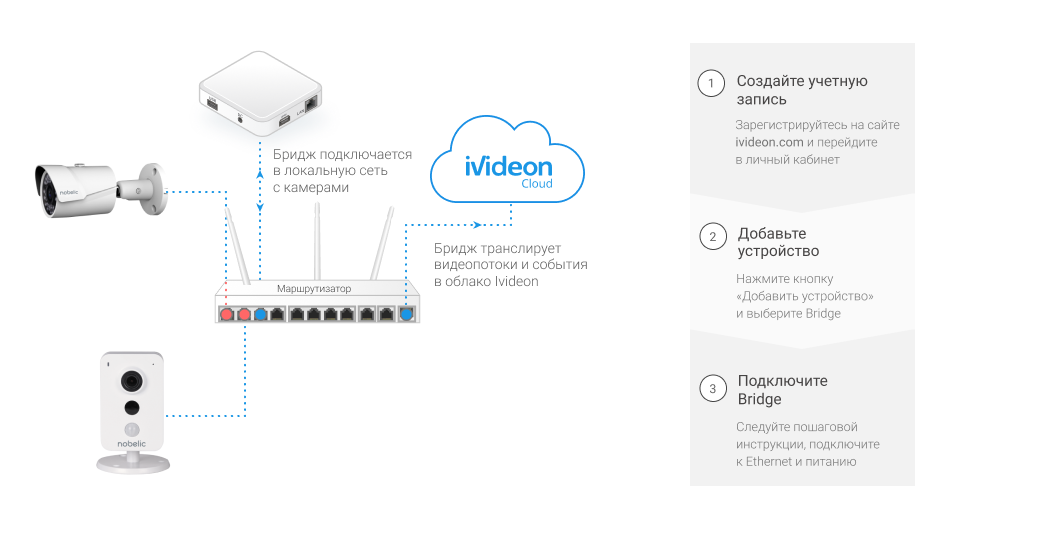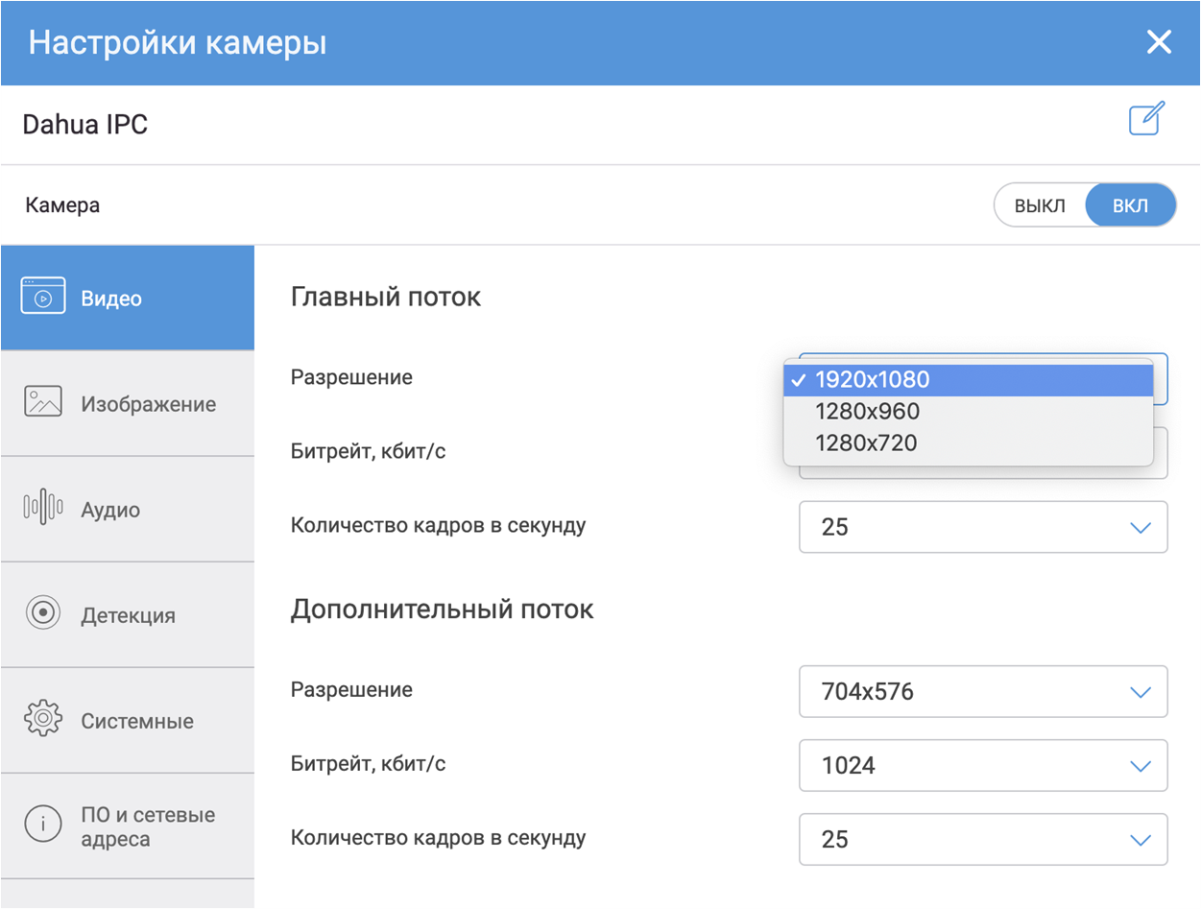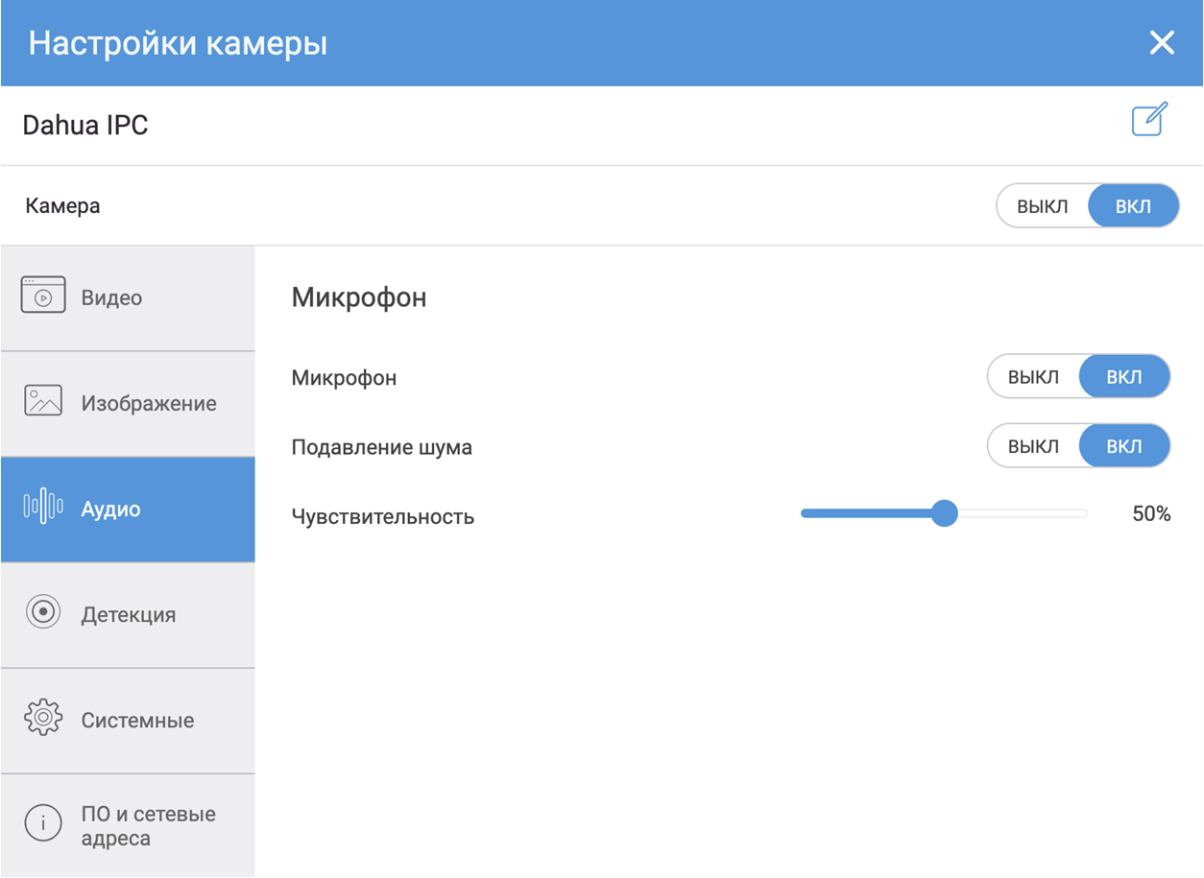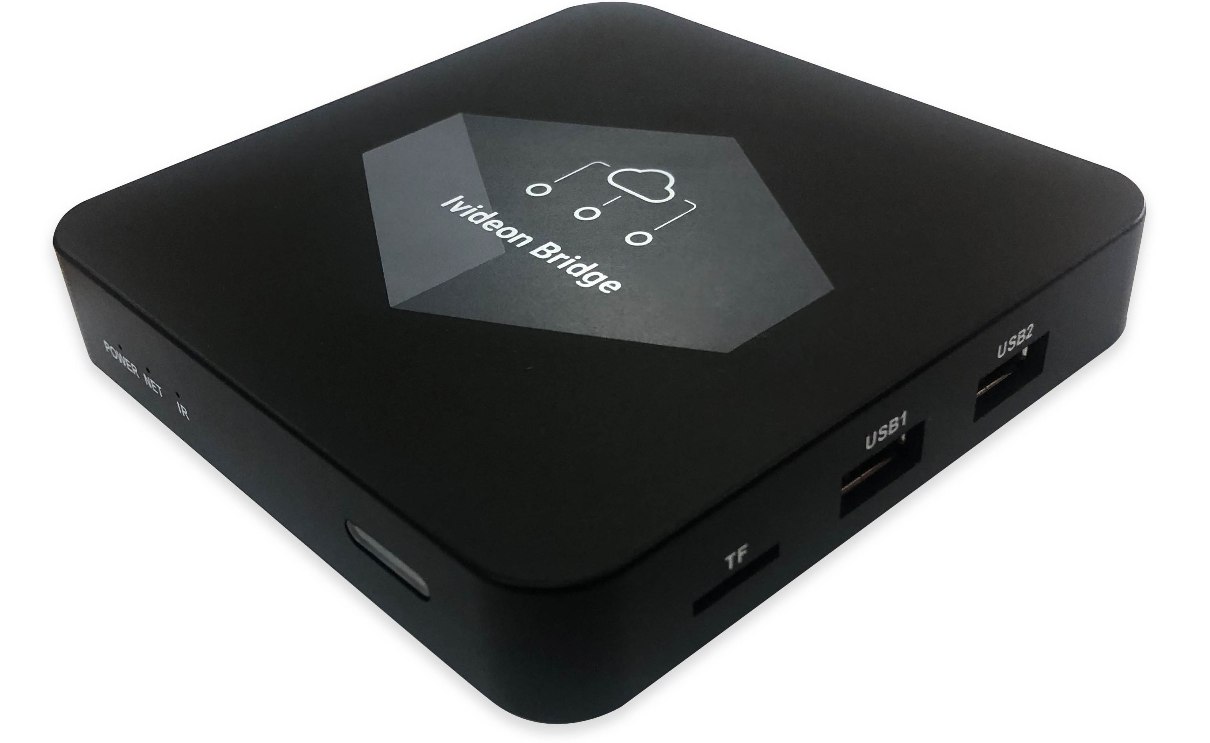Ivideon Bridge: how to connect legacy CCTV systems to the cloud

Having once deployed a video surveillance system and then scaling it, users often become “hostages” of installed equipment. Moving from one iron and service provider to another is expensive.
There are many manufacturers on the market who create their own services, placing another pet in a large zoo of solutions. It’s difficult to “make friends” in one project different equipment, but we figured out how to do it.
')
Today we’ll tell you about the Ivideon Bridge project, which without additional equipment (PCs and DVRs) will integrate your video surveillance system with Ivideon.
Ivideon Bridge - a device that allows you to connect up to 16 cameras (or DVR channels) to our service. Its main purpose is to give local users access to a modern cloud-based service for video surveillance and video analytics with minimal costs and without replacing installed equipment.
Of course, before, such an opportunity also existed. Depending on the tasks, we connect clients using DVRs with our firmware or using NVR with Ivideon Server installed. We also allow connection to the service from any computer - be it an enterprise server or a home PC.
These solutions have disadvantages - limited convenience and relatively high cost. After evaluating customer requests, weighing all the advantages and disadvantages of existing methods of connecting to our cloud, we have developed a fundamentally new device that combines low price and high functionality. Now you can get by with the affordable small device that makes it easy to "wrap" all video surveillance in the cloud. A compact device in many cases will replace a PC with Ivideon Server or a registrar.
7 key advantages of the gadget , in addition to the obvious advantages of accessing the Ivideon service:
- low cost;
- work with 16 cameras or DVR channels connected in any combination;
- ease of connection - Bridge automatically finds devices on the network;
- ease of setup - for the first time, users get actually Ivideon Server, which is configured remotely from your personal account;
- a wide range of supported devices: cameras, DVR, as well as any other devices or VMS that support RTSP or ONVIF;
- event recording for ONVIF; permanent recording to the cloud for RTSP on tariffs for business;
- a wide range of functions for Hikvision and Dahua equipment through the use of native protocols - work with a local archive on the terminal device.
Ivideon Bridge is not just another DVR, but a plug and play device that greatly simplifies remote administration. For the first time in the Ivideon Server class solution, it is now possible to administer through the cloud.
When to Use Ivideon Bridge

For example, a few years ago you installed a video surveillance system in the store from the most affordable cameras on the market. The system only shows and stores video from the trading floor and ticket counter. Over time, you realized that cameras do not have enough opportunities to increase business efficiency - competitors have already developed systems with employee time monitoring, queue detection, and smart notifications.
It may be unprofitable for you to install a new system and dismantle the previous one, but Ivideon Bridge will provide easy access to video analytics and new functions without replacing all cameras. You can even add analog cameras to the cloud - through a DVR connected to Ivideon Bridge.
If we consider the device in the context of cloud-based camera connection and remote access to the EDGE archive, then you just need to set a lower tariff plan - for example, the minimum annual cost for 8 cameras in the cloud will be only 1,600 rubles / month or 19,200 rubles / year.
5 situations in which you need a device:
- You want to expand your existing CCTV system and buy new Ivideon cameras. You get Ivideon Bridge to pick up the old system in the cloud and combine it with the new one in a single personal account.
- The facility has cameras without remote access. Ivideon Bridge will help you get multiple access to live streams and archive, convenient client applications, remote notifications and settings.
- You have several stores with different video surveillance systems (use different applications to log in). You want to combine them into one system, centrally configure and monitor the performance of devices in one personal account.
- The operation service plans to optimize its work: due to the configuration through the cloud, it is not necessary to have physical or remote network access to the device, you can add cameras to clients through your personal account - the client connects the device to the network, and the specialist of the service organization performs all other actions remotely.
- Ivideon partners simplify user support. It is enough for the end customer to physically connect two cables to Ivideon Bridge, and all necessary settings will be made remotely by the supplier.
Bridge Features and Features

Externally, the device is a compact box with ports that fits easily in the palm of your hand. The "heart" of the bridge is a single-board microcomputer based on a quad-core 64-bit ARM CPU with a frequency of 2 GHz and 2 GB of RAM on board.
To connect the bridge, a 220-volt outlet and a free port on network equipment with Internet access are required. We did our best to make the device work out of the box by default, but in rare cases you will need to connect a monitor and keyboard - for example, to configure a network connection if there is no DHCP server in the network.
Ivideon Bridge supports working with 16 cameras or channels of the DVR in any combination. The total bit rate of all connected cameras should not exceed 32 Mbit / s: you can connect 16 cameras of 2 Mbit / s or 8 cameras with a bitrate of 4 Mbit / s. Other combinations are allowed.
Ivideon Bridge software includes a specialized version of Ivideon Server that has closer integration with Ivideon Backend, an API feature for managing and configuring through the cloud.
All device management functions are implemented in the Ivideon cloud, there is no local graphical interface on the device. For the first time in the Ivideon Server class solution, remote administration via the cloud is implemented - connecting and configuring cameras to the device is performed completely in Ivideon's personal account.
The bridge also has a number of auxiliary system services designed to ensure stable operation of the device and OTA (over the air) updates. The software of the device, including security patches and new features, users will easily and free of charge update from their personal account.
Connection and setup

Connecting the cameras to Ivideon Bridge is as simple as possible - in most cases it is enough to know only the login and password of the camera. All configuration and management of the "bridge" is now carried out through the Ivideon user account, and in the future we will add management support in our mobile applications.
The bridge connection procedure is fully consistent with the algorithm for adding a camera with built-in Ivideon firmware.
Step 1. Register at Ivideon.
Step 2. Go to your personal account, click the "Add device" button, select Ivideon Bridge. Here you will need to indicate the name of the device and enter the serial number indicated on the case or on the packing box. Follow the instructions below. During the registration process, you will need to connect Ivideon Bridge to the network port of the router and turn on the power. Registration will take several minutes.
Starting an Ivideon Bridge Connection

Step 3. Connect your cameras and DVRs to Bridge.
Automatic camera search on the network

The connected camera should at least work on the RTSP protocol, or better, support ONVIF, which will give more Ivideon functions. Unlike Ivideon Server, there is no built-in motion detector on the Bridge, so motion recording will not work for RTSP cameras, only a permanent archive recording on business rates is possible.
The cherry on the cake is the support of the native Dahua and Hikvision ISAPI protocols in Ivideon Bridge: users of devices from these manufacturers will have access to the local archive directly on the camera or DVR, as well as OSD and motion detector settings, including setting the detection zone.
Immediately after going to the settings, Ivideon Bridge will search for cameras and recorders on the network. To connect a detected device, click on it, enter the login and password and, if necessary, other settings, make sure that the video on the preview is displayed correctly and confirm the connection of the camera.
Connecting a detected camera

We have provided the ability to expertly configure the connection of cameras. This mode is required if you plan to connect an old recorder or camera to the cloud that cannot be detected automatically. This situation is possible when Bridge is in a different network segment and discovery protocols that operate on the basis of broadcast packets cannot find the device automatically.
The manual connection mode will help if necessary to set “custom” settings for video streams - for example, specify the main low-stream on the camera or set non-standard ports for RTSP streams.
Due to the flexibility of the Bridge settings, the user can easily cope with situations when the IP address, username / password of the camera is changed or the device is being replaced. By changing the camera, you will not lose the previously recorded video archive in the cloud and the already paid subscription to the service. And we, in turn, will promptly expand support for new cameras and recorders.
We summarize: Bridge provides a large selection of options when connecting devices, and gives access to Ivideon devices from different manufacturers. At the same time, we “squeeze” the maximum of capabilities from the connected device in accordance with its real characteristics.
Depending on the supported protocol, one or another set of functions will be available on the connected camera in Ivideon. The most functional case is the Dahua and Hikvision devices that Bridge communicates with using native protocols. When connecting models of these manufacturers, the user will have access to the video archive on the device itself.
| Device type | Work with two streams of audio / video | Sound / Motion Detection | PTZ control | Manage Stream Settings | Work with the local archive of the camera or recorder |
|---|---|---|---|---|---|
| Generic IP camera (RTSP) |  |  |  |  |  |
| Generic ONVIF device |  |  |  |  |  |
| Dahua device |  |  |  |  |  |
| Hikvision (ISAPI) device |  |  |  |  |  |
Configure devices connected via Bridge
Let's look at an example with the settings of Dahua / Hikvision cameras.
1. Change video stream parameters

2. Image customization, including backlight control and OSD text

3. Microphone setup

4. Configuring motion and sound detection

And a number of other settings, the list of which will be updated.
Conclusion

The cost of Ivideon Bridge is 6,000 rubles. In terms of price / channel ratio, Bridge is becoming the most profitable way to connect to Ivideon.
Compare for yourself:
- camera - from 5 500 rubles / channel;
- NVR - from 3 200 rubles / channel;
- DVR with HDD - from 1,500 rubles / channel;
- Bridge - from 375 rubles / channel.
Even if compared with devices without built-in Ivideon support, the bridge still remains more profitable:
HiWatch 104 with support for HikConnect and support for 4 cameras - from 1 087 rub / channel (for installers already taking into account the discount).
Customers who plan to modernize an existing video surveillance system often face the need to maintain both old and new equipment, with different characteristics, capabilities and management interfaces. CCTV upgrade issues are now resolved with Ivideon Bridge.
You can contact us for pre-order here .
Source: https://habr.com/ru/post/461159/
All Articles